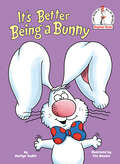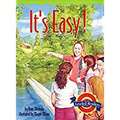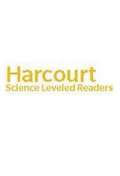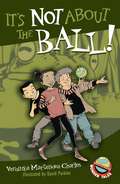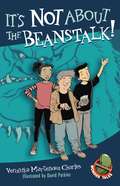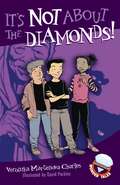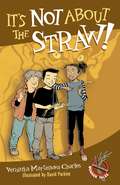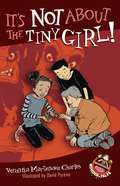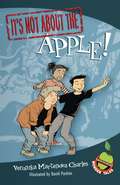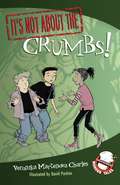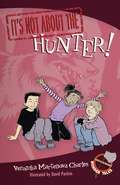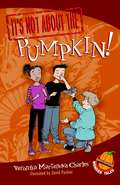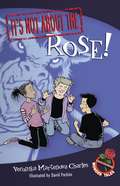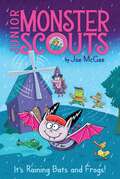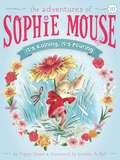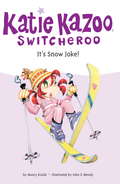- Table View
- List View
It's Better Being a Bunny (Beginner Books(R))
by Marilyn SadlerPerfect for Easter or celebrating bunnies all year round. A charming follow-up to the classic Beginner Book It&’s Not Easy Being a Bunny!P.J. Funnybunny is back and more lovable than ever in this sweet, funny sequel. P.J. Funnybunny is not having a good day. His mom won't let him eat ice cream for breakfast. She won't let him hang upside down from a tree. She won't even let him watch a scary movie! P.J. visits Potts Pig, whose mom lets them do all those things. But when he gets a stomachache and has a bad dream, P.J. Funnybunny realizes that--while it's fun to be a pig--it's better being a bunny! This new tale of self-discovery is the perfect Easter treat for beginning readers and bunny fans of all ages!
It's In The System: Systems of Linear Equations and Inequalities
by Glenda Lappan James T. Fey Susan N. Friel Elizabeth Difanis PhillipsNIMAC-sourced textbook
It's Magnetic! (Into Reading, Benchmark 3-6, Level P #7)
by Richard Torrey Helen GreatheadNIMAC-sourced textbook
It's Not About the Ball! (Easy-to-Read Wonder Tales #6)
by David Parkins Veronika Martenova CharlesMore first books for fledgling readers that offer the enjoyment of a good story with the thrill of accomplishment that comes from independent reading. Written in short, easy phrases with carefully selected vocabulary and plentiful illustrations, each book helps youngsters achieve success as they have fun.The series follows three friends who love to share stories. In each book, one is reminded of a well-known story: It's Not About the Ball! is based on The Frog Prince; It' Not About the Tiny Girl! is based on Thumbelina; It's Not About the Diamonds! is based on the story of Diamonds and Toads; It's Not About the Straw! is based on Rumpelstiltskin and It's Not About the Beanstalk! is based on Jack and the Beanstalk.As one friend starts his story, the others are reminded of versions they know so each volume has three stories within one framework. The stories come from around the world, and Veronika Martenova Charles provides a note at the end of each book to describe the origins.Easy-to-Read Wonder Tales are a great first step in developing a lifelong love of reading, and it makes a fine companion to Veronika Martenova Charles's series, Easy-to-Read Spooky Tales.From the Trade Paperback edition.
It's Not About the Beanstalk! (Easy-to-Read Wonder Tales #10)
by David Parkins Veronika Martenova CharlesMore first books for fledgling readers that offer the enjoyment of a good story with the thrill of accomplishment that comes from independent reading. Written in short, easy phrases with carefully selected vocabulary and plentiful illustrations, each book helps youngsters achieve success as they have fun.The series follows three friends who love to share stories. In each book, one is reminded of a well-known story: It's Not About the Ball! is based on The Frog Prince; It' Not About the Tiny Girl! is based on Thumbelina; It's Not About the Diamonds! is based on the story of Diamonds and Toads; It's Not About the Straw! is based on Rumpelstiltskin and It's Not About the Beanstalk! is based on Jack and the Beanstalk.As one friend starts his story, the others are reminded of versions they know so each volume has three stories within one framework. The stories come from around the world, and Veronika Martenova Charles provides a note at the end of each book to describe the origins.Easy-to-Read Wonder Tales are a great first step in developing a lifelong love of reading, and it makes a fine companion to Veronika Martenova Charles's series, Easy-to-Read Spooky Tales.From the Trade Paperback edition.
It's Not About the Diamonds! (Easy-to-Read Wonder Tales #8)
by David Parkins Veronika Martenova CharlesMore first books for fledgling readers that offer the enjoyment of a good story with the thrill of accomplishment that comes from independent reading. Written in short, easy phrases with carefully selected vocabulary and plentiful illustrations, each book helps youngsters achieve success as they have fun.The series follows three friends who love to share stories. In each book, one is reminded of a well-known story: It's Not About the Ball! is based on The Frog Prince; It' Not About the Tiny Girl! is based on Thumbelina; It's Not About the Diamonds! is based on the story of Diamonds and Toads; It's Not About the Straw! is based on Rumpelstiltskin and It's Not About the Beanstalk! is based on Jack and the Beanstalk.As one friend starts his story, the others are reminded of versions they know so each volume has three stories within one framework. The stories come from around the world, and Veronika Martenova Charles provides a note at the end of each book to describe the origins.Easy-to-Read Wonder Tales are a great first step in developing a lifelong love of reading, and it makes a fine companion to Veronika Martenova Charles's series, Easy-to-Read Spooky Tales.From the Trade Paperback edition.
It's Not About the Straw! (Easy-to-Read Wonder Tales #9)
by David Parkins Veronika Martenova CharlesMore first books for fledgling readers that offer the enjoyment of a good story with the thrill of accomplishment that comes from independent reading. Written in short, easy phrases with carefully selected vocabulary and plentiful illustrations, each book helps youngsters achieve success as they have fun.The series follows three friends who love to share stories. In each book, one is reminded of a well-known story: It's Not About the Ball! is based on The Frog Prince; It' Not About the Tiny Girl! is based on Thumbelina; It's Not About the Diamonds! is based on the story of Diamonds and Toads; It's Not About the Straw! is based on Rumpelstiltskin and It's Not About the Beanstalk! is based on Jack and the Beanstalk.As one friend starts his story, the others are reminded of versions they know so each volume has three stories within one framework. The stories come from around the world, and Veronika Martenova Charles provides a note at the end of each book to describe the origins.Easy-to-Read Wonder Tales are a great first step in developing a lifelong love of reading, and it makes a fine companion to Veronika Martenova Charles's series, Easy-to-Read Spooky Tales.From the Trade Paperback edition.
It's Not About the Tiny Girl! (Easy-to-Read Wonder Tales #7)
by David Parkins Veronika Martenova CharlesMore first books for fledgling readers that offer the enjoyment of a good story with the thrill of accomplishment that comes from independent reading. Written in short, easy phrases with carefully selected vocabulary and plentiful illustrations, each book helps youngsters achieve success as they have fun.The series follows three friends who love to share stories. In each book, one is reminded of a well-known story: It's Not About the Ball! is based on The Frog Prince; It' Not About the Tiny Girl! is based on Thumbelina; It's Not About the Diamonds! is based on the story of Diamonds and Toads; It's Not About the Straw! is based on Rumpelstiltskin and It's Not About the Beanstalk! is based on Jack and the Beanstalk.As one friend starts his story, the others are reminded of versions they know so each volume has three stories within one framework. The stories come from around the world, and Veronika Martenova Charles provides a note at the end of each book to describe the origins.Easy-to-Read Wonder Tales are a great first step in developing a lifelong love of reading, and it makes a fine companion to Veronika Martenova Charles's series, Easy-to-Read Spooky Tales.From the Trade Paperback edition.
It's Not about the Apple! (Easy-to-Read Wonder Tales)
by David Parkins Veronika Martenova CharlesHere are five first books for fledgling readers that offer the enjoyment of a good story along with the thrill of accomplishment that comes from independent reading. Written in short, easy phrases with carefully selected vocabulary and plentiful illustrations, each book helps youngsters achieve success as they have fun. The series follows three friends who love to share stories. In each book, one is reminded of a well-known story: Little Red Riding Hood in It's Not About the Hunter!, Beauty and the Beast in It's Not About the Rose!, Snow White in It's Not About the Apple!, Cinderella in It's Not About the Pumpkin!, and Hansel and Gretel in It's Not About the Crumbs! As one friend starts, the others are reminded of versions they know so each volume has three stories within one framework. The stories come from around the world, and Veronika Martenova Charles provides a note at the end of each book to describe the origins. Easy-To-Read Wonder Tales is a great first step in developing a lifelong love of reading, and it makes a fine companion to Veronika Martenova Charles's series, Easy-To-Read Spooky Tales.From the Trade Paperback edition.
It's Not about the Crumbs! (Easy-to-Read Wonder Tales)
by David Parkins Veronika Martenova CharlesHere are five first books for fledgling readers that offer the enjoyment of a good story along with the thrill of accomplishment that comes from independent reading. Written in short, easy phrases with carefully selected vocabulary and plentiful illustrations, each book helps youngsters achieve success as they have fun. The series follows three friends who love to share stories. In each book, one is reminded of a well-known story: Little Red Riding Hood in It's Not About the Hunter!, Beauty and the Beast in It's Not About the Rose!, Snow White in It's Not About the Apple!, Cinderella in It's Not About the Pumpkin!, and Hansel and Gretel in It's Not About the Crumbs! As one friend starts, the others are reminded of versions they know so each volume has three stories within one framework. The stories come from around the world, and Veronika Martenova Charles provides a note at the end of each book to describe the origins. Easy-To-Read Wonder Tales is a great first step in developing a lifelong love of reading, and it makes a fine companion to Veronika Martenova Charles's series, Easy-To-Read Spooky Tales.From the Trade Paperback edition.
It's Not about the Hunter! (Easy-to-Read Wonder Tales)
by David Parkins Veronika Martenova CharlesHere are five first books for fledgling readers that offer the enjoyment of a good story along with the thrill of accomplishment that comes from independent reading. Written in short, easy phrases with carefully selected vocabulary and plentiful illustrations, each book helps youngsters achieve success as they have fun. The series follows three friends who love to share stories. In each book, one is reminded of a well-known story: Little Red Riding Hood in It's Not About the Hunter!, Beauty and the Beast in It's Not About the Rose!, Snow White in It's Not About the Apple!, Cinderella in It's Not About the Pumpkin!, and Hansel and Gretel in It's Not About the Crumbs! As one friend starts, the others are reminded of versions they know so each volume has three stories within one framework. The stories come from around the world, and Veronika Martenova Charles provides a note at the end of each book to describe the origins. Easy-To-Read Wonder Tales is a great first step in developing a lifelong love of reading, and it makes a fine companion to Veronika Martenova Charles's series, Easy-To-Read Spooky Tales.From the Trade Paperback edition.
It's Not about the Pumpkin! (Easy-to-Read Wonder Tales)
by David Parkins Veronika Martenova CharlesHere are five first books for fledgling readers that offer the enjoyment of a good story along with the thrill of accomplishment that comes from independent reading. Written in short, easy phrases with carefully selected vocabulary and plentiful illustrations, each book helps youngsters achieve success as they have fun. The series follows three friends who love to share stories. In each book, one is reminded of a well-known story: Little Red Riding Hood in It's Not About the Hunter!, Beauty and the Beast in It's Not About the Rose!, Snow White in It's Not About the Apple!, Cinderella in It's Not About the Pumpkin!, and Hansel and Gretel in It's Not About the Crumbs! As one friend starts, the others are reminded of versions they know so each volume has three stories within one framework. The stories come from around the world, and Veronika Martenova Charles provides a note at the end of each book to describe the origins. Easy-To-Read Wonder Tales is a great first step in developing a lifelong love of reading, and it makes a fine companion to Veronika Martenova Charles's series, Easy-To-Read Spooky Tales.From the Trade Paperback edition.
It's Not about the Rose! (Easy-to-Read Wonder Tales)
by David Parkins Veronika Martenova CharlesHere are five first books for fledgling readers that offer the enjoyment of a good story along with the thrill of accomplishment that comes from independent reading. Written in short, easy phrases with carefully selected vocabulary and plentiful illustrations, each book helps youngsters achieve success as they have fun. The series follows three friends who love to share stories. In each book, one is reminded of a well-known story: Little Red Riding Hood in It's Not About the Hunter!, Beauty and the Beast in It's Not About the Rose!, Snow White in It's Not About the Apple!, Cinderella in It's Not About the Pumpkin!, and Hansel and Gretel in It's Not About the Crumbs! As one friend starts, the others are reminded of versions they know so each volume has three stories within one framework. The stories come from around the world, and Veronika Martenova Charles provides a note at the end of each book to describe the origins. Easy-To-Read Wonder Tales is a great first step in developing a lifelong love of reading, and it makes a fine companion to Veronika Martenova Charles's series, Easy-To-Read Spooky Tales.From the Trade Paperback edition.
It's Raining Bats and Frogs! (Junior Monster Scouts #3)
by Joe McGeeA rainstorm gets out of hand and it&’s up to the Junior Monster Scouts to save The Village from washing away in the hilarious third chapter book of the Junior Monster Scouts series!It&’s a rainy day in The Village and rain means puddles. Lots of puddles to splash in and lots of rain to sing in. Singing and splashing is loud. And loud is something Baron Von Grump simply cannot stand. But Baron Von Grump has a plan. If he can get rid of the rain clouds, he&’ll get rid of the rain and all the noise! But the Baron&’s plan backfires and now it&’s raining and pouring, with no end in sight! Meanwhile, Laguna, a little swampling is learning how to swim. Only she&’s pretty scared of the water! Can Laguna and the Junior Monster Scouts learn how to overcome fears and save the town from overflowing?
It's Raining, It's Pouring (The Adventures of Sophie Mouse #10)
by Poppy GreenSophie Mouse and her furry friends prepare for a big storm that’s headed right for Silverlake Forest in this tenth charming book of The Adventures of Sophie Mouse series!Sophie Mouse has been preparing for the first-ever Silverlake Forest Spring Fling for weeks. She has come up with activities, like a Lily Pad Dance, she’s thought of games to play, and she’s created all sorts of fun hats, masks, and other costumes for her friends to wear. But the day of the Spring Fling is approaching, and Sophie’s twitching whiskers are telling her that the rain is too! Sure enough, it rains and it pours. Will Sophie figure out a way to save the day or will all her hard work go to down the drain? With easy-to-read language and illustrations on almost every page, the Adventures of Sophie Mouse chapter books are perfect for beginning readers.
It's Snow Joke (Katie Kazoo, Switcheroo #22)
by Nancy KrulikKatie's actress friend Rosie invites her to a movie shoot at a ski lodge during winter break. Katie can't wait to hit the slopes for the first time. But unfortunately, the magic wind doesn't ever take a break. When Katie turns into the ski instructor, she lands in a very slippery situation. How will Katie fix her troubles this time? .

